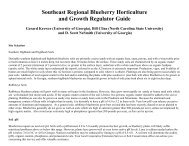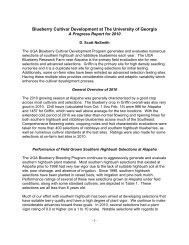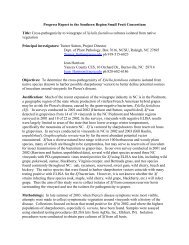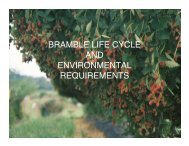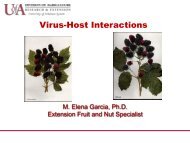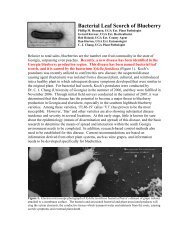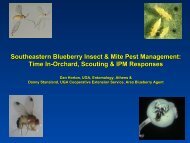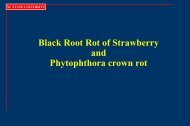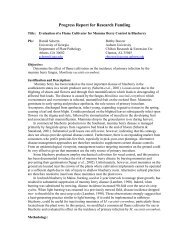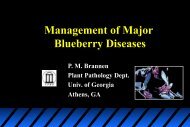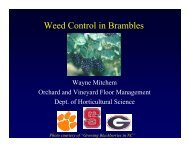Bacterial Leaf Scorch of Blueberry - The Southern Region Small ...
Bacterial Leaf Scorch of Blueberry - The Southern Region Small ...
Bacterial Leaf Scorch of Blueberry - The Southern Region Small ...
Create successful ePaper yourself
Turn your PDF publications into a flip-book with our unique Google optimized e-Paper software.
<strong>Bacterial</strong> <strong>Leaf</strong> <strong>Scorch</strong> <strong>of</strong><br />
<strong>Blueberry</strong><br />
Don Hopkins<br />
Mid Florida REC<br />
University <strong>of</strong> Florida
<strong>Blueberry</strong> <strong>Leaf</strong> <strong>Scorch</strong><br />
Symptoms<br />
• First symptom is marginal leaf scorch,<br />
which may be bordered by a darker band.<br />
• <strong>Leaf</strong> drop occurs and young stems take on<br />
a yellow appearance.<br />
• Eventually plants die.
<strong>Leaf</strong> scorch Symptoms
Yellow stem symptoms
<strong>Leaf</strong> scorch rating<br />
5<br />
4<br />
3<br />
2<br />
1<br />
Pathogenicity <strong>of</strong> Xylella fastidiosa strains to Star<br />
CS20<br />
BB08-1<br />
BB08-2<br />
BB08-3<br />
0<br />
4 Months 6 Months<br />
Time after Inoculation
Pathogenicity <strong>of</strong> Xylella fastidiosa strains to Star<br />
<strong>Leaf</strong> scorch rating<br />
3<br />
2.5<br />
2<br />
1.5<br />
1<br />
0.5<br />
BB08-2<br />
Syc86-1<br />
EB06-1SC<br />
BKB95-1<br />
L95-1 EB96-1<br />
ML99-68 PD00-2<br />
Dixon<br />
0<br />
Three months after Inoculation
Pathogenicity <strong>of</strong> Xylella fastidiosa strains to V1 (2010 test<br />
<strong>Leaf</strong> scorch rating<br />
3<br />
2.5<br />
2<br />
1.5<br />
1<br />
0.5<br />
BB08-3<br />
Dixon<br />
EB06-1SC<br />
BKB95-1<br />
L95-1 EB96-1<br />
ML-CA PD08-1<br />
Oak92-6<br />
MT1<br />
0<br />
Four months after Inoculation
Pathogenicity <strong>of</strong> Xylella fastidiosa<br />
to <strong>Blueberry</strong><br />
• Strains from blueberry vary in virulence.<br />
• On Star, the strains BB08-2 and L95-1<br />
from lupine produced symptoms.<br />
• On V1, strains BB08-3, Dixon (almond),<br />
L95-1 (lupine), EB96-1 (elderberry), and<br />
EB06-1SC (elderberry) produced<br />
symptoms.
Resistance to <strong>Blueberry</strong> <strong>Leaf</strong> <strong>Scorch</strong><br />
• Cultivars vary in field susceptibility (Brannen, Harmon,<br />
and Scherm).<br />
• Most susceptible appeared to be FL86-19 (V1),<br />
Star, Jewel, and Countrywide.<br />
• Very little leaf scorch was observed in some<br />
cultivars, such as Emerald, Millennia, and <strong>Southern</strong><br />
Belle.<br />
• Can we screen for resistance in the greenhouse to<br />
obtain rapid evaluations <strong>of</strong> blueberry lines
Incidence (mean and range <strong>of</strong> the percentage <strong>of</strong> symptomatic plants) <strong>of</strong> bacterial<br />
leaf scorch in southern highbush blueberry cultivars in Georgia, based on a disease<br />
survey conducted in 2008.<br />
Brannen et al., 2008
Incidence (percentage <strong>of</strong> symptomatic plants) <strong>of</strong> bacterial leaf scorch by cultivar at one<br />
7th leaf producer site in Colquitt County. <strong>The</strong> number <strong>of</strong> rows surveyed (n) is shown in<br />
parentheses next to the cultivar name.<br />
P. Brannen, UGA
<strong>Blueberry</strong> leaf scorch symptom Development with<br />
10-fold dilution <strong>of</strong> 0.25 OD BB08-2 Inoculum (2009)<br />
4<br />
3<br />
2<br />
V1<br />
Star<br />
Windsor<br />
Emerald<br />
1<br />
0<br />
6<br />
wk<br />
8<br />
wk<br />
10<br />
wk<br />
12<br />
wk<br />
14<br />
wk<br />
16<br />
wk<br />
18<br />
wk
<strong>Blueberry</strong> leaf scorch symptom development<br />
with 0.25 OD BB08-3 inoculum (2010 test)<br />
4<br />
3<br />
V1<br />
Star<br />
Windsor<br />
Emerald<br />
2<br />
1<br />
0<br />
2 mo 3 mo 4 mo 5mo
FL<br />
86-19<br />
[V1]<br />
Emerald<br />
Millennium<br />
Windsor
<strong>Blueberry</strong> leaf scorch symptom development<br />
with 0.25 OD BB08-3 inoculum (2010 test)<br />
4<br />
3<br />
V1<br />
Climax<br />
<strong>Southern</strong> Belle<br />
Tif Blue<br />
Rebel<br />
2<br />
1<br />
0<br />
2 mo 3 mo 4 mo 5 mo
Comparison <strong>of</strong> Field Resistance to <strong>Blueberry</strong> <strong>Leaf</strong><br />
<strong>Scorch</strong> and Greenhouse Resistance<br />
Cultivar Field Greenhouse<br />
V1 Susceptible Susceptible<br />
Star Susceptible Moderate Res.<br />
Windsor Resistant Resistant<br />
Emerald Resistant Susceptible<br />
Rebel Susceptible Susceptible<br />
<strong>Southern</strong> Belle Resistant<br />
Resistant<br />
Climax Resistant<br />
Tif Blue Resistant
Pathogenicity <strong>of</strong> Xylella fastidiosa strains to Emerald, 2010 test<br />
<strong>Leaf</strong> scorch rating<br />
3<br />
2.5<br />
2<br />
1.5<br />
1<br />
0.5<br />
BB08-3 EB06-1SC<br />
BB08-1 B1-10 GA<br />
B2-64 GA B2-66 GA<br />
Buffer<br />
0<br />
Four months after Inoculation
Greenhouse Screening for Resistance<br />
to <strong>Leaf</strong> <strong>Scorch</strong><br />
• Resistance to blueberry leaf scorch in greenhouse<br />
screening agreed with observed field resistance for<br />
most cultivars.<br />
• Emerald was more susceptible to Xylella fastidiosa<br />
in the greenhouse than in the field.<br />
• Star appeared to be more resistant in greenhouse<br />
tests than has been observed in the field.<br />
• Differences between greenhouse and field<br />
observations could be due to host specificity <strong>of</strong><br />
strains, agressiveness <strong>of</strong> strains, or loss <strong>of</strong> virulence<br />
in some strains during culture.
Cross-Protection for Biological Control<br />
<strong>of</strong> Pierces Disease <strong>of</strong> Grape<br />
Cross protection is the phenomenon in<br />
which plant tissues infected with one<br />
strain <strong>of</strong> a pathogen are protected from<br />
infection by other more severe strains <strong>of</strong><br />
the same pathogen.
Field injections<br />
Current tests on new grape plantings <strong>of</strong> various grape genotypes
Thirteenth Season in the UF vineyard for Cabernet<br />
Sauvignon treated with Biocontrol strain EB92-1
% Pierce's disease<br />
60<br />
50<br />
40<br />
30<br />
20<br />
10<br />
0<br />
Cab.Franc Chamb. Cynth.<br />
Grape Genotypes<br />
Untreated<br />
EB92-1<br />
• Effect <strong>of</strong> strain EB92-1 is on PD in various genotypes, V. vinifera (Cabernet<br />
Franc), V. aestivalis (Cynthiana), and French/American hybrid<br />
(Chambourcin) in the vineyard in Central Florida.
Evaluation <strong>of</strong> Benign Strains <strong>of</strong> X. fastidiosa<br />
for the Biological Control <strong>of</strong> <strong>Blueberry</strong> <strong>Leaf</strong><br />
<strong>Scorch</strong> by Cross-Protection<br />
• Various strains <strong>of</strong> X. fastidiosa are being evaluated in the<br />
greenhouse for biological control <strong>of</strong> blueberry leaf<br />
scorch in Star and V1, including strains from<br />
elderberry, blackberry, sycamore, and mulberry.<br />
• Star and V1 blueberry plants inoculated with these<br />
strains were challenged 3-4 weeks later with the<br />
blueberry leaf scorch strain BB08-2 in 2009 or BB08-3 in<br />
2010 to evaluate biological control <strong>of</strong> the disease.<br />
• Disease incidence and severity are rated once a month.<br />
Don Hopkins, UF
Biological Control <strong>of</strong> <strong>Blueberry</strong> <strong>Leaf</strong> <strong>Scorch</strong> in Star<br />
<strong>Leaf</strong> scorch rating<br />
5<br />
4<br />
3<br />
2<br />
1<br />
Buffer EB92-1<br />
Syc86-1 BKB95-1<br />
L95-1 EB96-1<br />
ML99-68<br />
0<br />
Six months after Inoculation with BB08-2
Biological Control <strong>of</strong> <strong>Blueberry</strong> <strong>Leaf</strong> <strong>Scorch</strong><br />
in V1 (2010 test<br />
3<br />
Buffer<br />
EB92-1<br />
Syc86-1<br />
BKB95-1<br />
<strong>Leaf</strong> scorch rating<br />
2<br />
1<br />
Dixon<br />
PD00-2<br />
0<br />
Five months after Inoculation with BB08-3
Biocontrol <strong>of</strong> <strong>Blueberry</strong> <strong>Leaf</strong> <strong>Scorch</strong><br />
• In greenhouse tests, X. fastidiosa strains EB92-1<br />
and Syc86-1 reduced leaf scorch in both Star and<br />
V1. BKB95-1 provided biocontrol in Star and<br />
PD00-2 was effective in V1.<br />
• Strain PD00-2 is not a candidate for biocontrol <strong>of</strong><br />
blueberry leaf scorch, because it is pathogenic to<br />
grapevine.<br />
• Further greenhouse and field tests are warranted for<br />
EB92-1, Syc86-1, and possibly BKB95-1.
Summary<br />
• In addition to X. fastidiosa strains from blueberry,<br />
strains from lupine, almond, and elderberry were<br />
pathogenic to blueberry.<br />
• Resistance to blueberry leaf scorch in greenhouse<br />
screening agreed with observed field resistance for<br />
most cultivars. <strong>The</strong> development <strong>of</strong> a quick<br />
screening test for resistance to leaf scorch is<br />
possible.<br />
• Differences in virulence or host specificity were<br />
observed in X. fastidiosa strains used in greenhouse<br />
tests.<br />
• Greenhouse tests for the biological control <strong>of</strong> leaf<br />
scorch were positive. Field tests are needed.
Thank You for Your Attention!<br />
Research was supported byUSDA-NIFA award no.<br />
2008-51180-19579 (Specialty Crop Research Initiative)<br />
Thanks to colleagues:<br />
Phil Brannen<br />
Phil Harmon<br />
Harald Scherm



